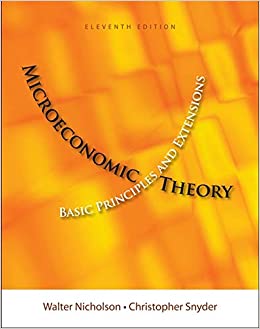
Microeconomic Theory 11th Edition by Walter Nicholson,Christopher Snyder
Edition 11ISBN: 978-1111525538
Microeconomic Theory 11th Edition by Walter Nicholson,Christopher Snyder
Edition 11ISBN: 978-1111525538 Exercise 1
Assume for simplicity that a monopolist has no costs of production and faces a demand curve given by Q = 150 - P.
a. Calculate the profit-maximizing price-quantity combination for this monopolist. Also calculate the monopolist's profit.
b. Suppose instead that there are two firms in the market facing the demand and cost conditions just described for their identical products. Firms choose quantities simultaneously as in the Cournot model. Compute the outputs in the Nash equilibrium. Also compute market output, price, and firm profits.
c. Suppose the two firms choose prices simultaneously as in the Bertrand model. Compute the prices in the Nash equilibrium. Also compute firm output and profit as well as market output.
d. Graph the demand curve and indicate where the market price-quantity combinations from parts (a)-(c) appear on the curve.
a. Calculate the profit-maximizing price-quantity combination for this monopolist. Also calculate the monopolist's profit.
b. Suppose instead that there are two firms in the market facing the demand and cost conditions just described for their identical products. Firms choose quantities simultaneously as in the Cournot model. Compute the outputs in the Nash equilibrium. Also compute market output, price, and firm profits.
c. Suppose the two firms choose prices simultaneously as in the Bertrand model. Compute the prices in the Nash equilibrium. Also compute firm output and profit as well as market output.
d. Graph the demand curve and indicate where the market price-quantity combinations from parts (a)-(c) appear on the curve.
Explanation
The demand curve shows the relation betw...
Microeconomic Theory 11th Edition by Walter Nicholson,Christopher Snyder
Why don’t you like this exercise?
Other Minimum 8 character and maximum 255 character
Character 255


